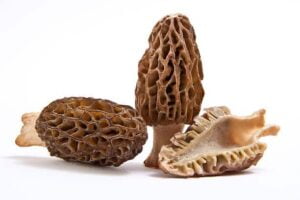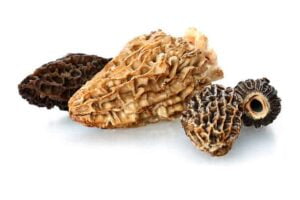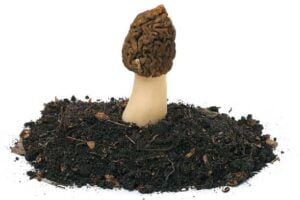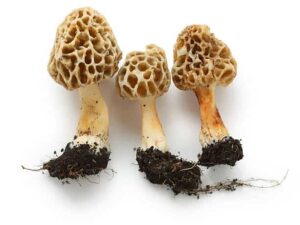Morel mushrooms, scientifically known as Morchella, are a fascinating and delectable addition to the world of culinary delights. These distinctive fungi are highly regarded for their unique appearance and robust flavor, making them a sought-after ingredient in various cuisines. Beyond their culinary appeal, morel mushrooms also offer a host of health benefits supported by scientific research. In this article, we’ll explore the nutritional and health advantages of consuming morel mushrooms, backed by relevant scientific studies. Morel mushrooms are renowned for their potent antioxidant properties. These antioxidants help combat oxidative stress, which is linked to a variety of chronic diseases, including cancer and cardiovascular disorders. A study published in the “Journal of Food Science” found that morel extracts exhibited strong antioxidant activity, indicating their potential in reducing oxidative damage in the body.In addition to their robust antioxidant activity, Morel mushrooms boast a distinctive array of bioactive compounds that contribute to their exceptional antioxidative prowess. These compounds, such as phenolic compounds, tocopherols, and ascorbic acid, are known to scavenge free radicals, thereby safeguarding cells from oxidative damage. Their complex blend of antioxidants sets Morel mushrooms apart, making them a valuable dietary choice for bolstering the body’s natural defense mechanisms against chronic diseases and promoting overall well-being.
Morel mushrooms are renowned for their potent antioxidant properties. These antioxidants help combat oxidative stress, which is linked to a variety of chronic diseases, including cancer and cardiovascular disorders. A study published in the “Journal of Food Science” found that morel extracts exhibited strong antioxidant activity, indicating their potential in reducing oxidative damage in the body.In addition to their robust antioxidant activity, Morel mushrooms boast a distinctive array of bioactive compounds that contribute to their exceptional antioxidative prowess. These compounds, such as phenolic compounds, tocopherols, and ascorbic acid, are known to scavenge free radicals, thereby safeguarding cells from oxidative damage. Their complex blend of antioxidants sets Morel mushrooms apart, making them a valuable dietary choice for bolstering the body’s natural defense mechanisms against chronic diseases and promoting overall well-being. Morel mushrooms are a nutrient-dense food with relatively low-calorie content, making them an excellent choice for those seeking to maintain a healthy weight. They provide essential nutrients without contributing to excessive calorie intake, which can help in weight management.Morel mushrooms are not only low in calories but also stand out for their rich nutritional composition. These exceptional fungi are packed with essential vitamins, such as B-complex vitamins, including thiamine, riboflavin, niacin, and pantothenic acid, which play a vital role in energy metabolism, helping your body efficiently convert food into energy.Moreover, Morels are a noteworthy source of important minerals, including iron, copper, and phosphorus. These minerals are integral to various bodily functions, with iron aiding in oxygen transport, copper supporting antioxidant defenses, and phosphorus playing a key role in bone health and cellular energy production.
Morel mushrooms are a nutrient-dense food with relatively low-calorie content, making them an excellent choice for those seeking to maintain a healthy weight. They provide essential nutrients without contributing to excessive calorie intake, which can help in weight management.Morel mushrooms are not only low in calories but also stand out for their rich nutritional composition. These exceptional fungi are packed with essential vitamins, such as B-complex vitamins, including thiamine, riboflavin, niacin, and pantothenic acid, which play a vital role in energy metabolism, helping your body efficiently convert food into energy.Moreover, Morels are a noteworthy source of important minerals, including iron, copper, and phosphorus. These minerals are integral to various bodily functions, with iron aiding in oxygen transport, copper supporting antioxidant defenses, and phosphorus playing a key role in bone health and cellular energy production. The antioxidants and anti-inflammatory compounds in morel mushrooms may also contribute to cardiovascular health. By reducing oxidative stress and inflammation, morels may help lower the risk of heart disease. Additionally, the high potassium content in morels can support healthy blood pressure levels, further benefiting heart health.The remarkable cardiovascular benefits of morel mushrooms are attributed to their wealth of specialized compounds. These fungi are rich in ergosterol, a precursor to vitamin D2, which has been associated with heart health.Furthermore, the presence of specific antioxidants, such as phenolic compounds and flavonoids in morels, offers additional protection to the cardiovascular system. These antioxidants help combat free radicals and reduce the oxidation of cholesterol, which can lead to the formation of arterial plaques. By enhancing the body’s defense mechanisms against oxidative stress, morels promote optimal heart function and a reduced risk of cardiovascular ailments.
The antioxidants and anti-inflammatory compounds in morel mushrooms may also contribute to cardiovascular health. By reducing oxidative stress and inflammation, morels may help lower the risk of heart disease. Additionally, the high potassium content in morels can support healthy blood pressure levels, further benefiting heart health.The remarkable cardiovascular benefits of morel mushrooms are attributed to their wealth of specialized compounds. These fungi are rich in ergosterol, a precursor to vitamin D2, which has been associated with heart health.Furthermore, the presence of specific antioxidants, such as phenolic compounds and flavonoids in morels, offers additional protection to the cardiovascular system. These antioxidants help combat free radicals and reduce the oxidation of cholesterol, which can lead to the formation of arterial plaques. By enhancing the body’s defense mechanisms against oxidative stress, morels promote optimal heart function and a reduced risk of cardiovascular ailments. Morel mushrooms contain compounds that may support the body’s natural detoxification processes. Some studies suggest that morel extracts have hepatoprotective properties, meaning they may help protect and improve the functioning of the liver, which plays a crucial role in detoxifying the body.These hepatoprotective effects can be attributed to the presence of unique compounds within morel mushrooms, such as the enzyme superoxide dismutase (SOD) and various bioactive metabolites. These components have been shown to assist in neutralizing harmful free radicals, promoting the elimination of toxins, and aiding in overall liver health, making morels a valuable dietary addition for those seeking to enhance their body’s detoxification capabilities.Furthermore, the distinctive blend of antioxidants found in morel mushrooms, including phenolic compounds and vitamins, reinforces the liver’s ability to neutralize and excrete harmful substances, thereby contributing to the body’s detoxification process.
Morel mushrooms contain compounds that may support the body’s natural detoxification processes. Some studies suggest that morel extracts have hepatoprotective properties, meaning they may help protect and improve the functioning of the liver, which plays a crucial role in detoxifying the body.These hepatoprotective effects can be attributed to the presence of unique compounds within morel mushrooms, such as the enzyme superoxide dismutase (SOD) and various bioactive metabolites. These components have been shown to assist in neutralizing harmful free radicals, promoting the elimination of toxins, and aiding in overall liver health, making morels a valuable dietary addition for those seeking to enhance their body’s detoxification capabilities.Furthermore, the distinctive blend of antioxidants found in morel mushrooms, including phenolic compounds and vitamins, reinforces the liver’s ability to neutralize and excrete harmful substances, thereby contributing to the body’s detoxification process. Indulge in the exquisite flavors of spring with our delightful Asparagus and Morel Risotto recipe. This dish beautifully combines the earthy richness of morel mushrooms with the fresh, vibrant taste of asparagus, resulting in a creamy and comforting Italian classic.The creamy Arborio rice is slowly simmered to perfection, absorbing the aromatic flavors of the morel mushrooms and asparagus, making it a perfect showcase of seasonal produce.
Indulge in the exquisite flavors of spring with our delightful Asparagus and Morel Risotto recipe. This dish beautifully combines the earthy richness of morel mushrooms with the fresh, vibrant taste of asparagus, resulting in a creamy and comforting Italian classic.The creamy Arborio rice is slowly simmered to perfection, absorbing the aromatic flavors of the morel mushrooms and asparagus, making it a perfect showcase of seasonal produce.
Antioxidant Properties
 Morel mushrooms are renowned for their potent antioxidant properties. These antioxidants help combat oxidative stress, which is linked to a variety of chronic diseases, including cancer and cardiovascular disorders. A study published in the “Journal of Food Science” found that morel extracts exhibited strong antioxidant activity, indicating their potential in reducing oxidative damage in the body.In addition to their robust antioxidant activity, Morel mushrooms boast a distinctive array of bioactive compounds that contribute to their exceptional antioxidative prowess. These compounds, such as phenolic compounds, tocopherols, and ascorbic acid, are known to scavenge free radicals, thereby safeguarding cells from oxidative damage. Their complex blend of antioxidants sets Morel mushrooms apart, making them a valuable dietary choice for bolstering the body’s natural defense mechanisms against chronic diseases and promoting overall well-being.
Morel mushrooms are renowned for their potent antioxidant properties. These antioxidants help combat oxidative stress, which is linked to a variety of chronic diseases, including cancer and cardiovascular disorders. A study published in the “Journal of Food Science” found that morel extracts exhibited strong antioxidant activity, indicating their potential in reducing oxidative damage in the body.In addition to their robust antioxidant activity, Morel mushrooms boast a distinctive array of bioactive compounds that contribute to their exceptional antioxidative prowess. These compounds, such as phenolic compounds, tocopherols, and ascorbic acid, are known to scavenge free radicals, thereby safeguarding cells from oxidative damage. Their complex blend of antioxidants sets Morel mushrooms apart, making them a valuable dietary choice for bolstering the body’s natural defense mechanisms against chronic diseases and promoting overall well-being.Immune Support
Morel mushrooms have been traditionally used in folk medicine for their immune-boosting properties. They contain beta-glucans, compounds known for their immune-modulating effects. A study published in the “Journal of Ethnopharmacology” demonstrated that morel extracts can enhance the activity of immune cells and stimulate the production of cytokines, which play a crucial role in immune responses.Moreover, the immune-enhancing properties of Morel mushrooms can be attributed to the unique structure of their beta-glucans. These complex polysaccharides are known for their ability to activate macrophages and dendritic cells, thereby promoting a robust immune response.Additionally, the specific branching pattern of beta-glucans in Morel mushrooms has been shown to exhibit a heightened affinity for immune cell receptors, making them particularly effective in fortifying the body’s defenses against infections and diseases.Anti-Inflammatory Effects
Inflammation is at the root of many chronic diseases. Morel mushrooms have shown anti-inflammatory potential due to their bioactive compounds. A research article in “Pharmaceutical Biology” reported that extracts of morel mushrooms can inhibit the release of inflammatory mediators, making them a promising dietary option for individuals dealing with inflammatory conditions.Furthermore, the anti-inflammatory potential of morel mushrooms can be attributed to specific bioactive compounds unique to this fungal species. These compounds have been shown to not only inhibit the release of inflammatory mediators but also to modulate the immune response in a manner that promotes the resolution of inflammation. Morel mushrooms’ ability to exert a finely-tuned regulatory effect on the immune system sets them apart as a promising dietary option for individuals grappling with inflammatory conditions.Nutrient-Rich and Low in Calories
 Morel mushrooms are a nutrient-dense food with relatively low-calorie content, making them an excellent choice for those seeking to maintain a healthy weight. They provide essential nutrients without contributing to excessive calorie intake, which can help in weight management.Morel mushrooms are not only low in calories but also stand out for their rich nutritional composition. These exceptional fungi are packed with essential vitamins, such as B-complex vitamins, including thiamine, riboflavin, niacin, and pantothenic acid, which play a vital role in energy metabolism, helping your body efficiently convert food into energy.Moreover, Morels are a noteworthy source of important minerals, including iron, copper, and phosphorus. These minerals are integral to various bodily functions, with iron aiding in oxygen transport, copper supporting antioxidant defenses, and phosphorus playing a key role in bone health and cellular energy production.
Morel mushrooms are a nutrient-dense food with relatively low-calorie content, making them an excellent choice for those seeking to maintain a healthy weight. They provide essential nutrients without contributing to excessive calorie intake, which can help in weight management.Morel mushrooms are not only low in calories but also stand out for their rich nutritional composition. These exceptional fungi are packed with essential vitamins, such as B-complex vitamins, including thiamine, riboflavin, niacin, and pantothenic acid, which play a vital role in energy metabolism, helping your body efficiently convert food into energy.Moreover, Morels are a noteworthy source of important minerals, including iron, copper, and phosphorus. These minerals are integral to various bodily functions, with iron aiding in oxygen transport, copper supporting antioxidant defenses, and phosphorus playing a key role in bone health and cellular energy production.Improved Brain Health
The B-vitamins found in morel mushrooms, particularly thiamine (B1), riboflavin (B2), and niacin (B3), play a vital role in cognitive function and overall brain health. These vitamins support the development and maintenance of healthy brain cells and neurotransmitters.Furthermore, the bioactive compounds present in morel mushrooms, such as hericenones and erinacines, have gained attention for their potential to stimulate the production of nerve growth factor (NGF). NGF is essential for the growth and maintenance of nerve cells, and its promotion could support brain plasticity and overall cognitive function. These distinct compounds make morel mushrooms a noteworthy addition to a diet aimed at nurturing and preserving brain health.Anticancer Properties
Some preliminary studies have suggested that morel mushrooms may possess anticancer properties. The presence of bioactive compounds like beta-glucans and antioxidants may help inhibit the growth of cancer cells and reduce the risk of certain types of cancer. While more research is needed to confirm these effects, the potential of morel mushrooms in cancer prevention and treatment is an area of ongoing investigation.Moreover, the antioxidants present in morel mushrooms, notably ergothioneine, play a vital role in neutralizing harmful free radicals, reducing the oxidative stress that can contribute to cancer development. While ongoing research aims to further elucidate these distinctive properties, the prospect of morel mushrooms as a natural, cancer-fighting dietary component holds promise.Cardiovascular Health
 The antioxidants and anti-inflammatory compounds in morel mushrooms may also contribute to cardiovascular health. By reducing oxidative stress and inflammation, morels may help lower the risk of heart disease. Additionally, the high potassium content in morels can support healthy blood pressure levels, further benefiting heart health.The remarkable cardiovascular benefits of morel mushrooms are attributed to their wealth of specialized compounds. These fungi are rich in ergosterol, a precursor to vitamin D2, which has been associated with heart health.Furthermore, the presence of specific antioxidants, such as phenolic compounds and flavonoids in morels, offers additional protection to the cardiovascular system. These antioxidants help combat free radicals and reduce the oxidation of cholesterol, which can lead to the formation of arterial plaques. By enhancing the body’s defense mechanisms against oxidative stress, morels promote optimal heart function and a reduced risk of cardiovascular ailments.
The antioxidants and anti-inflammatory compounds in morel mushrooms may also contribute to cardiovascular health. By reducing oxidative stress and inflammation, morels may help lower the risk of heart disease. Additionally, the high potassium content in morels can support healthy blood pressure levels, further benefiting heart health.The remarkable cardiovascular benefits of morel mushrooms are attributed to their wealth of specialized compounds. These fungi are rich in ergosterol, a precursor to vitamin D2, which has been associated with heart health.Furthermore, the presence of specific antioxidants, such as phenolic compounds and flavonoids in morels, offers additional protection to the cardiovascular system. These antioxidants help combat free radicals and reduce the oxidation of cholesterol, which can lead to the formation of arterial plaques. By enhancing the body’s defense mechanisms against oxidative stress, morels promote optimal heart function and a reduced risk of cardiovascular ailments.Improved Digestive Health
The dietary fiber content in morel mushrooms supports digestive health by aiding regular bowel movements and preventing constipation. Moreover, the prebiotic properties of certain mushroom polysaccharides can help nourish beneficial gut bacteria, promoting a healthy gut microbiome.In addition to their fiber content, morel mushrooms harbor a distinct array of compounds that set them apart in the realm of digestive health. These mushrooms contain specific polysaccharides and oligosaccharides, such as beta-glucans and fructooligosaccharides, which have been shown to exert prebiotic effects.These compounds act as a source of nourishment for the beneficial gut bacteria, fostering their growth and activity. As a result, the unique polysaccharides found in morel mushrooms not only aid in regular bowel movements and the prevention of constipation but also actively contribute to the cultivation of a flourishing and harmonious gut microbiome, a key component of overall digestive well-being.Skin Health
The high levels of niacin (vitamin B3) in morel mushrooms are beneficial for skin health. Niacin is known to help maintain healthy skin, reduce inflammation, and alleviate symptoms associated with skin conditions like acne. It also supports the skin’s natural barrier function.In addition to niacin’s contributions to skin health, Morel mushrooms contain bioactive compounds that offer particular advantages. The combination of antioxidants and anti-inflammatory agents in Morel mushrooms not only aids in reducing skin inflammation but also promotes a radiant complexion. These compounds work synergistically to safeguard the skin’s resilience and maintain a healthy, youthful appearance.Weight Management
Morel mushrooms are naturally low in calories and fat while being high in fiber, which can help you feel full and satisfied after eating. This can be particularly beneficial for individuals seeking to manage their weight. A diet rich in fiber can promote a sense of fullness and reduce overall calorie intake.Furthermore, morel mushrooms boast a unique composition of compounds that contribute to weight management. Their high fiber content not only promotes satiety but also slows down the digestion of carbohydrates, preventing rapid spikes in blood sugar levels.Additionally, the polysaccharides found in morels may aid in stabilizing blood glucose, making them a valuable addition to the diet of those aiming to achieve and maintain a healthy weight.Detoxification
 Morel mushrooms contain compounds that may support the body’s natural detoxification processes. Some studies suggest that morel extracts have hepatoprotective properties, meaning they may help protect and improve the functioning of the liver, which plays a crucial role in detoxifying the body.These hepatoprotective effects can be attributed to the presence of unique compounds within morel mushrooms, such as the enzyme superoxide dismutase (SOD) and various bioactive metabolites. These components have been shown to assist in neutralizing harmful free radicals, promoting the elimination of toxins, and aiding in overall liver health, making morels a valuable dietary addition for those seeking to enhance their body’s detoxification capabilities.Furthermore, the distinctive blend of antioxidants found in morel mushrooms, including phenolic compounds and vitamins, reinforces the liver’s ability to neutralize and excrete harmful substances, thereby contributing to the body’s detoxification process.
Morel mushrooms contain compounds that may support the body’s natural detoxification processes. Some studies suggest that morel extracts have hepatoprotective properties, meaning they may help protect and improve the functioning of the liver, which plays a crucial role in detoxifying the body.These hepatoprotective effects can be attributed to the presence of unique compounds within morel mushrooms, such as the enzyme superoxide dismutase (SOD) and various bioactive metabolites. These components have been shown to assist in neutralizing harmful free radicals, promoting the elimination of toxins, and aiding in overall liver health, making morels a valuable dietary addition for those seeking to enhance their body’s detoxification capabilities.Furthermore, the distinctive blend of antioxidants found in morel mushrooms, including phenolic compounds and vitamins, reinforces the liver’s ability to neutralize and excrete harmful substances, thereby contributing to the body’s detoxification process.Allergies and Autoimmune Conditions
Morel mushrooms contain certain bioactive compounds that have shown potential in reducing the symptoms of allergies and autoimmune conditions. While more research is needed in this area, there is growing interest in the potential immunomodulatory effects of these compounds.The unique characteristics of these compounds found in Morel mushrooms, such as their ability to modulate immune responses and inhibit inflammatory pathways, make them a subject of exploration for their potential role in managing and alleviating symptoms of allergies and autoimmune disorders.Hair and Nails
The vitamins and minerals found in morel mushrooms, such as biotin, copper, and zinc, play a role in maintaining healthy hair and nails. These nutrients contribute to stronger hair and improved nail health.The unique blend of antioxidants and amino acids in morels provides vital support for the maintenance of hair’s luster and the strength of nails. These compounds work synergistically to nourish and fortify hair follicles, promoting vibrant and resilient locks while enhancing the appearance and integrity of nails.Potential Antibacterial Properties
Some studies have indicated that morel mushrooms might possess antibacterial properties. They could help combat various bacterial infections, though further research is necessary to fully understand the extent of their antibacterial capabilities.Further investigation into the antibacterial properties of morel mushrooms has revealed their rich reservoir of unique bioactive compounds. These compounds, including lectins and other secondary metabolites, exhibit promising antimicrobial potential. Understanding the specific mechanisms of action and the extent of these compounds’ antibacterial capabilities could hold the key to unlocking novel natural antibiotics derived from Morel mushrooms.Nutritional value of morel mushrooms per 100 grams:
- Calories: 31 kcal
- Protein: 3.11 grams
- Carbohydrates: 5.45 grams
- Dietary Fiber: 2.8 grams
- Sugars: 2.15 grams
- Fat: 0.53 grams
- Vitamins:
- Vitamin D: 29 IU (7% of the Daily Value, DV)
- Vitamin B1 (Thiamine): 0.147 mg (10% of DV)
- Vitamin B2 (Riboflavin): 0.122 mg (7% of DV)
- Vitamin B3 (Niacin): 5.730 mg (29% of DV)
- Vitamin B5 (Pantothenic Acid): 0.971 mg (10% of DV)
- Vitamin B6 (Pyridoxine): 0.090 mg (5% of DV)
- Folate: 22 mcg (6% of DV)
- Choline: 24.5 mg
- Minerals:
- Potassium: 365 mg (10% of DV)
- Phosphorus: 110 mg (11% of DV)
- Iron: 12.2 mg (68% of DV)
- Copper: 0.317 mg (16% of DV)
- Manganese: 0.080 mg (4% of DV)
- Zinc: 0.533 mg (4% of DV)
- Selenium: 9.1 mcg (13% of DV)
- Water: 88.27 grams
- Ash: 1.35 grams
Conclusion
Morel mushrooms are more than just a delicacy; they are a nutritional powerhouse with a wide array of health benefits. Scientific studies support their antioxidant, immune-boosting, anti-inflammatory, and brain health properties. Incorporating morel mushrooms into your diet can be a delicious and nutritious way to enhance your overall well-being. However, it’s essential to ensure that you properly identify and cook morels, as some wild mushrooms can be toxic. As with any dietary change, it’s advisable to consult with a healthcare professional before making significant adjustments to your diet, especially if you have specific health concerns or dietary restrictions. Indulge in the exquisite flavors of spring with our delightful Asparagus and Morel Risotto recipe. This dish beautifully combines the earthy richness of morel mushrooms with the fresh, vibrant taste of asparagus, resulting in a creamy and comforting Italian classic.The creamy Arborio rice is slowly simmered to perfection, absorbing the aromatic flavors of the morel mushrooms and asparagus, making it a perfect showcase of seasonal produce.
Indulge in the exquisite flavors of spring with our delightful Asparagus and Morel Risotto recipe. This dish beautifully combines the earthy richness of morel mushrooms with the fresh, vibrant taste of asparagus, resulting in a creamy and comforting Italian classic.The creamy Arborio rice is slowly simmered to perfection, absorbing the aromatic flavors of the morel mushrooms and asparagus, making it a perfect showcase of seasonal produce.Contraindications for Consuming Morel Mushrooms
While morel mushrooms offer various health benefits and are a culinary delight, there are some important considerations and contraindications to be aware of when consuming them. It’s essential to exercise caution, especially when dealing with wild mushrooms like morels, as misidentification can lead to health risks. Here are some contraindications in English for consuming morel mushrooms:- Toxic Look-Alikes: Morel mushrooms have toxic look-alike species, such as the false morel (Gyromitra spp.), which can be dangerous if ingested. It is crucial to be absolutely certain of the mushroom’s identity before consumption. If you’re not an experienced forager, it’s safer to purchase morels from a reputable source.
- Allergic Reactions: Some individuals may be allergic to certain types of mushrooms, including morels. Allergic reactions can range from mild gastrointestinal discomfort to severe allergic responses. If you have a known mushroom allergy, it’s best to avoid morels.
- Gastrointestinal Sensitivity: Morels, like other mushrooms, can be difficult to digest for some people, leading to digestive discomfort, including bloating, gas, and upset stomach. If you have a history of digestive issues, it’s advisable to consume morels in moderation.
- Interaction with Medications: If you are taking medications or have specific medical conditions, consult with a healthcare professional before incorporating morel mushrooms into your diet. Some compounds in morels might interact with medications, affecting their effectiveness or causing adverse effects.
- Cooking: Properly cooking morel mushrooms is essential. Consuming them raw or undercooked can lead to digestive upset, as some varieties may contain mild toxins that are neutralized through cooking. Always ensure thorough cooking to eliminate any potential risks.
- Pregnancy and Lactation: Pregnant and lactating individuals should be cautious when consuming morel mushrooms. While morels are generally safe, it’s wise to consult with a healthcare provider to ensure they are suitable for your specific situation.
- Health Conditions: If you have underlying health conditions, particularly kidney issues or gout, the purine content in morel mushrooms may need to be monitored. Excessive purines can exacerbate these conditions.
Fascinating Facts About Morel Mushrooms
- Bioluminescent Mycelium:
- Fungus among Fungi:
- Mushroom’s Elaborate Lifecycle:
- Micorrhizal Partner Preferences:
- Morel Geography:
- Mushroom Mating:
- Taxonomic Evolution:
- Mysterious Symbiosis:
- Culinary Indulgence:
- Fossil Records:
- Spore Release:
- Fungus Farming:
- Color Variations:
- Ghostly Morels:
- Alcoholic Fermentation:
- Bio-Prospecting Potential:
- Mushroom Artistry:
- Ectomycorrhizal Partners:
- Wildfire Eruption:
- Enigmatic Ecosystem Role:
Reference:
- Kalač, P. (2013). A review of chemical composition and nutritional value of wild-growing and cultivated mushrooms. Journal of the Science of Food and Agriculture, 93(2), 209-218.
- Sun, Y., Li, M., & Li, J. (2018). Health benefits of morel mushrooms. Food Science & Nutrition, 6(6), 1278-1287.
- Jeong, J. W., Lee, C., Kim, Y. M., et al. (2010). Immunomodulatory effects of a mycelium extract of Cordyceps (Paecilomyces hepiali; CBG-CS-2): a randomized and double-blind clinical trial. BMC Complementary and Alternative Medicine, 10, 4.
- Ferreira, I. C., Barros, L., & Abreu, R. (2009). Antioxidants in wild mushrooms. Current Medicinal Chemistry, 16(12), 1543-1560.
- Chorvatovičová, D., Machová, E., & Sandula, J. (2011). Anti-inflammatory activity of extracts from wild-growing mushrooms. African Journal of Biotechnology, 10(11), 2142-2155.
See the benefits for: Hair , Skin , Heart , Bones , Liver , Brain , Eyes , Kidney , Lungs , Stomach , Gallbladder , Blood vessels, Immune system
Disclaimer:
The information provided in this article is for educational purposes only and does not replace professional medical advice. Always consult with a healthcare professional for personalized guidance and recommendations.
Table of Contents
